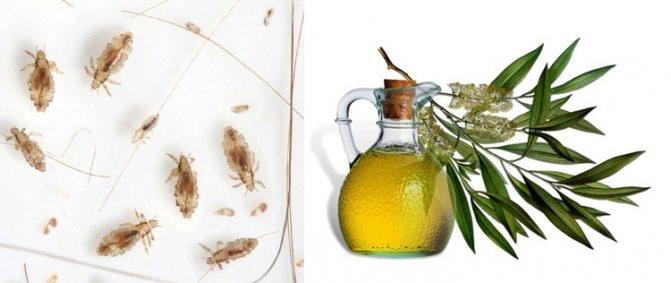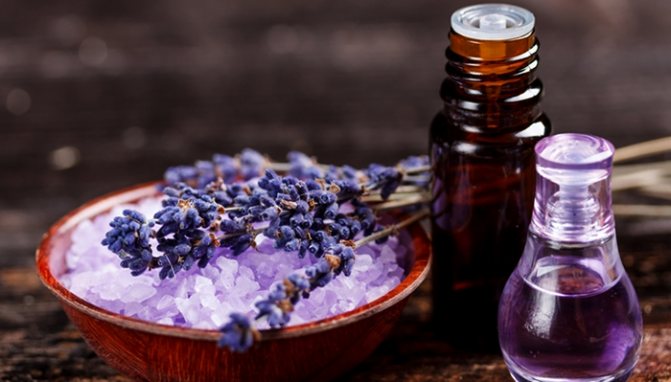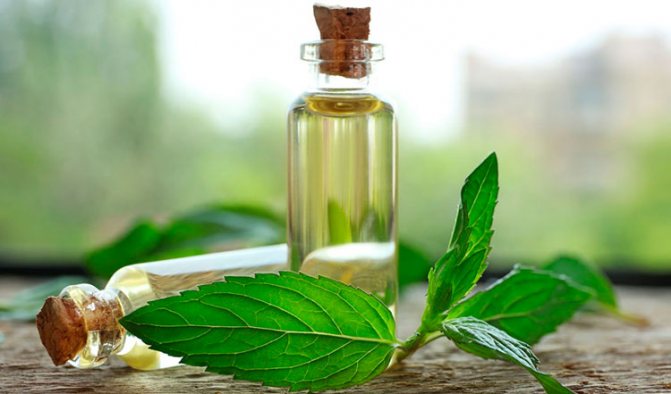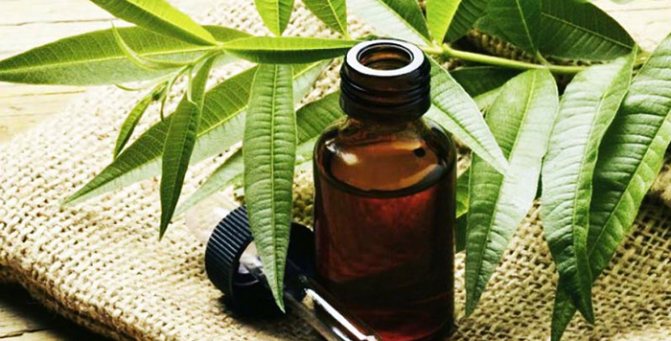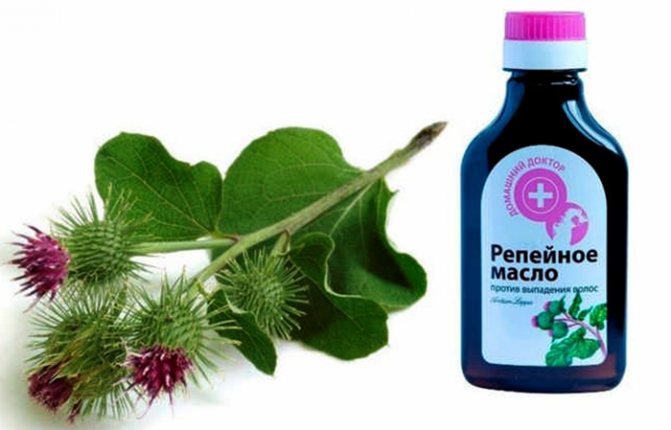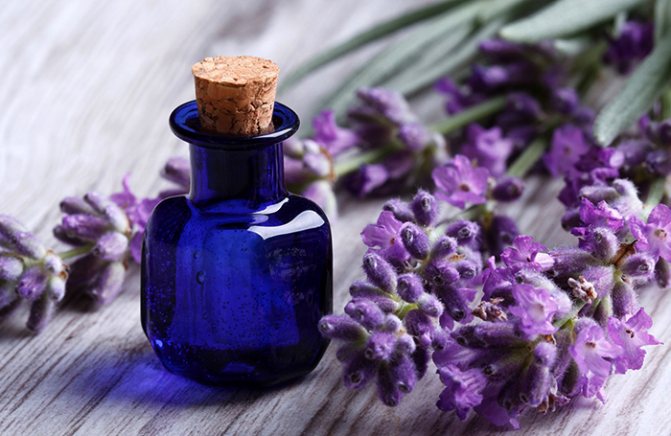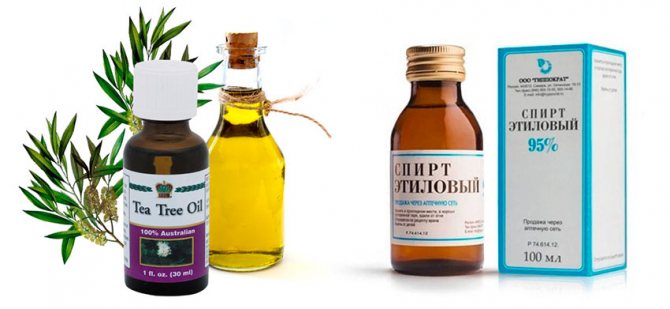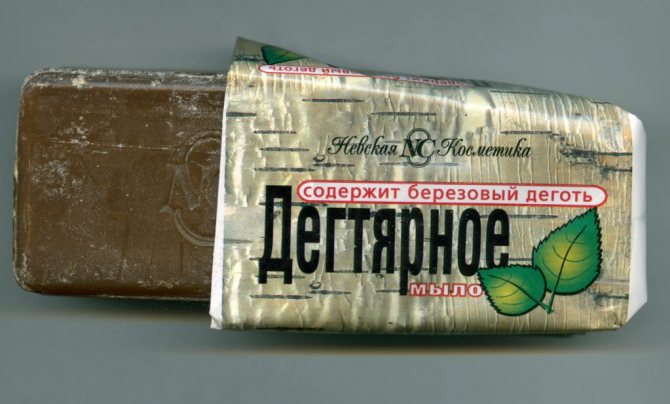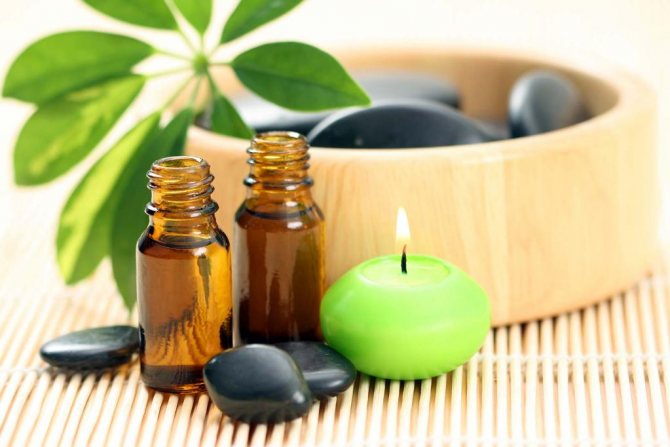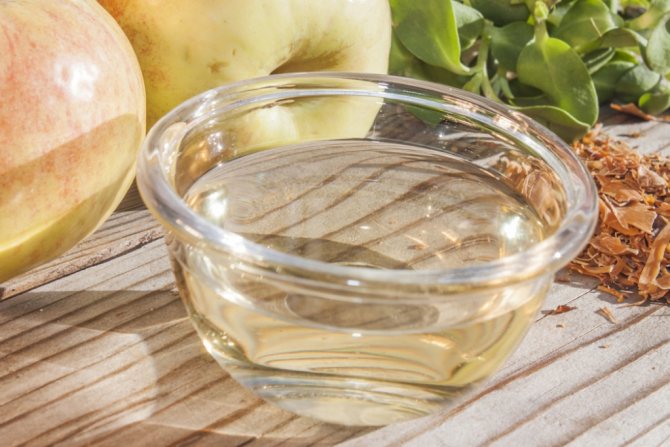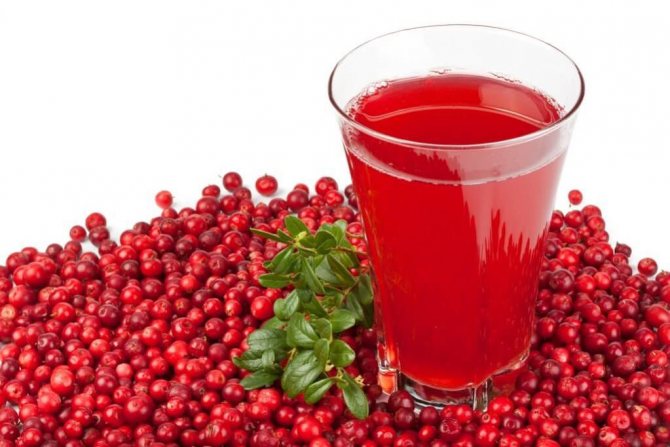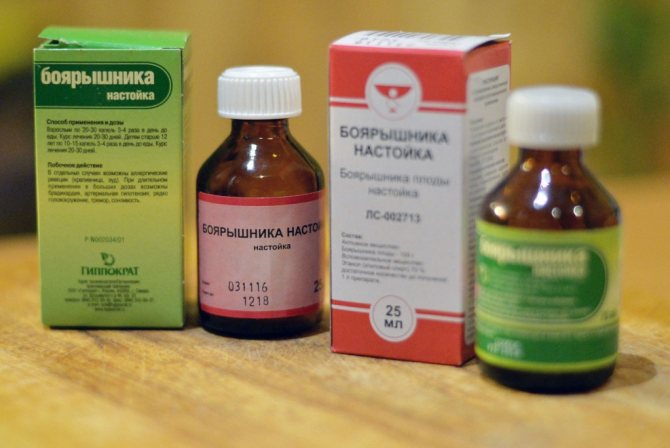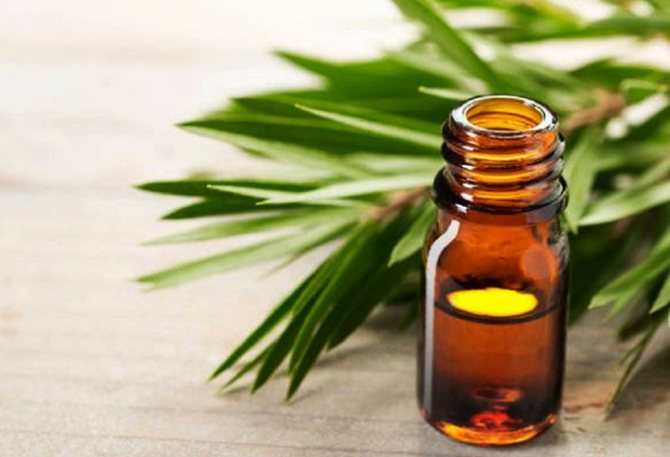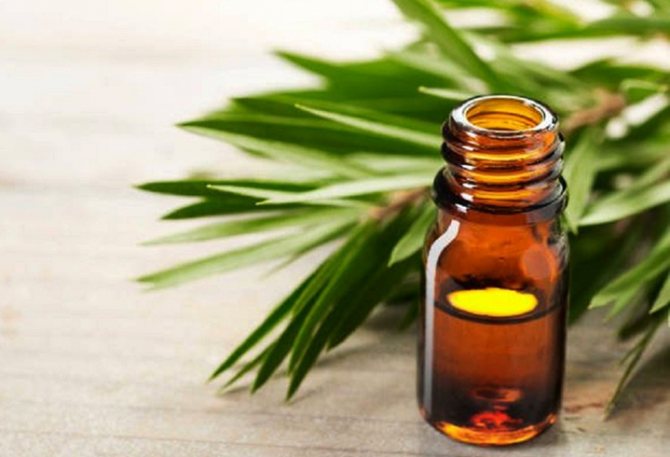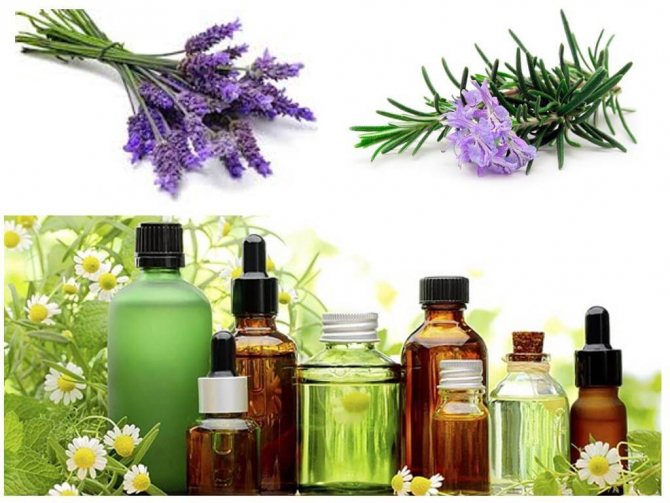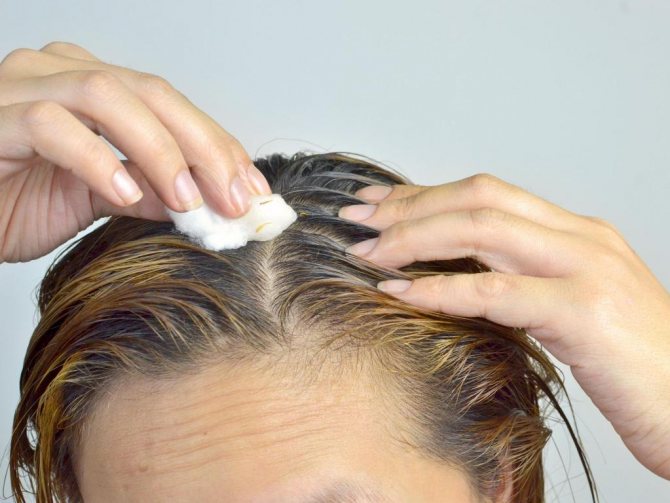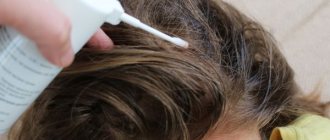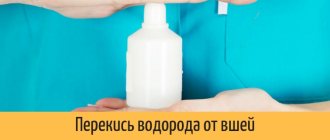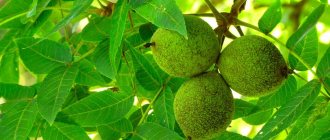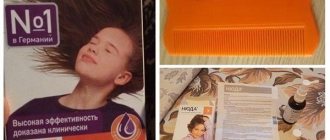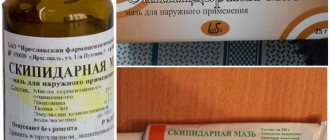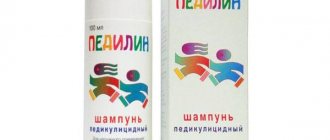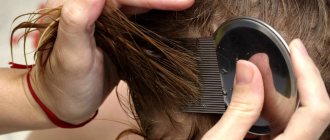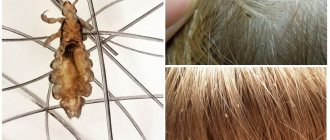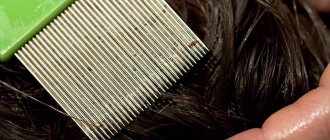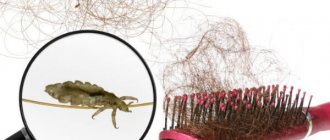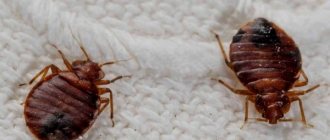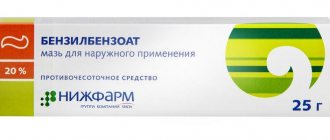The main folk methods of dealing with head lice include:
- vinegar solution.
- Kerosene.
- Dust soap.
- Cranberry juice.
- Herbal decoctions.
Traditional methods of dealing with head lice:
Lately, more and more the method of getting rid of lice with the help of essential oils begins to enjoy popularityThe most effective are tea tree oil. This is a completely natural remedy that is safe for humans, but harmful to insects.
Properties of essential oils
Essential oils against lice and nits are widely used in the treatment of head lice, as they have insecticidal, antibacterial and even antifungal properties. At the same time, they are practically safe for humans, which cannot be said about preparations of the chemical composition:
- Oils have a positive effect on the beauty and health of hair, giving it strength, shine and silkiness.
- The principle of action of oils is based on the structure of the product. Treatment of the head with a viscous mixture causes an attack of suffocation in insects, as a result of which they die.
- They do not like lice and a strong saturated aroma that repels insects.
- A mixture of essential or any vegetable oil with an acidic medium (vinegar or lemon juice) will be fatal not only for lice, but also for nits. Such a compound dissolves the shell of the eggs, and also liquefies the cementitious substance with which they are attached to the hair, which facilitates the process of combing out the nits.
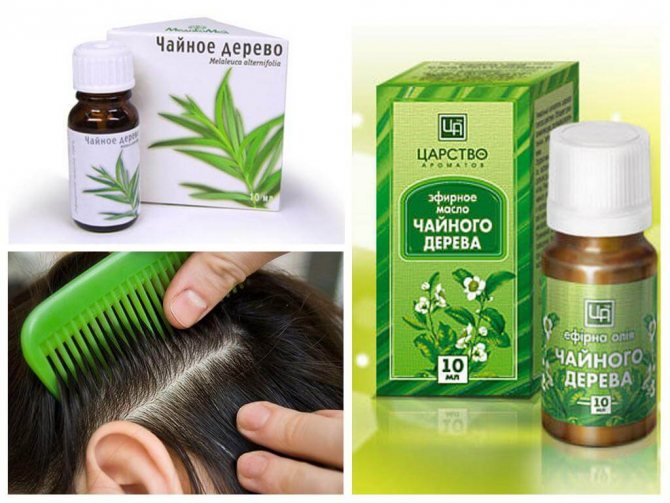
Tea tree oil
Important!
The only side effect that essential oils can cause when used is the occurrence of an allergic reaction in people with hypersensitivity or individual intolerance.
The most effective results with lice are shown by such types of essential oils as:
- lavender, aniseed;
- burdock, bergamot;
- eucalyptus, castor.
Sunflower, tea tree and geranium oils can also be included in this list. When choosing a medicinal oil, it is necessary to take into account the individual characteristics of the body, as well as the properties of the product itself.
Characteristics of anise oil
For the production of a herbal preparation from the seeds of anise, steam distillation of finely grated fruits of anise ordinary is used, which is grown in the countries of South and North America, in India, in some African countries and in southern Europe. On the territory of the Russian Federation there are plantations of anise, but only in the wild, it does not take root, and therefore, it is grown mainly artificially. The plant is about 70 centimeters tall, blooms with small white flowers and produces gray-brown fruits.
This plant-based substance is considered very valuable, because for the production of 1 kilogram of a medicinal agent, more than 45 kilograms of crushed anise seeds will need to be used.
Burdock
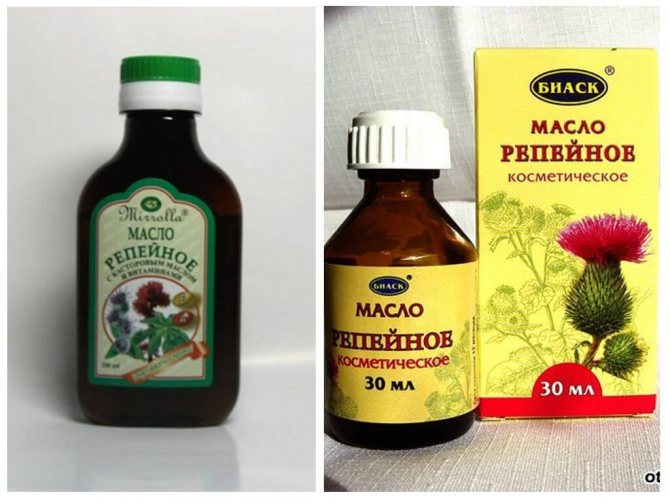

Burr oil
Burdock oil for lice and nits is one of the most popular natural remedies for hair problems. It also has an excellent effect in the treatment of head lice. The oil not only heals the scalp, but also creates a protective film.It is she who contributes to the difficulty of feeding and moving the parasites.
The head treated with burdock oil is wrapped in a plastic bag. After an hour, the hair is washed with running water using a mild shampoo. After that, the dead lice and nits are combed out with a pediculicidal comb. This treatment is carried out for 3 days. To achieve the maximum effect, as well as for prevention purposes, the treatment is repeated every week.
A little about lice and how they are infected
Pediculosis is nothing more than a lice infestation. There are 3 types of lice: head louse, body louse and pubic louse. They feed on blood by biting through human skin. The patient feels periodic itching with bites, and sometimes the movement of lice on the scalp and other parts of the body. Lice breed, leaving nits on the hair shafts. With a large number of "insects", nits can be seen mainly on the scalp, as well as in other areas where hair grows quite densely (genitals, male chest) and on dark clothes.
Children communicate very closely in schools and kindergartens. It is popular to try on each other's things, in this case, hats and clothes of an infected person are dangerous. In adolescence, girls like to use at best one comb for two, at worst - for the whole company. The same goes for various hair accessories. The danger in such a seemingly innocent manifestation of friendship lies in the probable transfer of nits and lice themselves between a sick child and healthy children.
Adults also quite often become owners of "head inhabitants". As a rule, this happens after visiting places with low sanitary conditions (hostess, low-level sanatorium) or after infection from a child who became infected from other children. In this case, all family members are subject to treatment and prevention.
Tea tree
Another effective remedy is tea tree oil for lice. It has an amazing effect when combined with alcohol. In addition to the antiseptic effect, such a mixture acts on the dense chitinous covers of parasites, destroying them.
To prepare a medicinal mixture, 30 g of tea tree oil must be mixed with 50 g of ethyl alcohol. Then add 50 g of distilled water. The resulting solution is treated with the scalp for 5-6 days.
As a prophylaxis, tea tree oil can be added to shampoo, as well as by a point method applied to the temples, crown and ears.
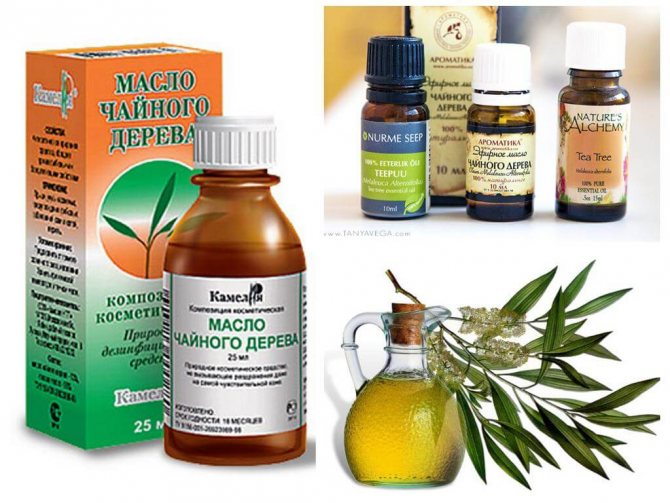

Tea tree oil
Feedback
A neighbor advised me to use tea tree oil for lice. I decided to use this method, as I considered it the safest in comparison with pharmaceutical preparations. I treated the head with oil for 4 days, and then combed it out with a comb. I managed to get rid of lice and nits completely. But this method did not help my sister - either the processing was of lower quality, or a high degree of parasite infestation.
Galina, Kursk
How to understand that lice have gotten?
Diagnosing a lice infestation is not difficult, the first sign will be severe itching of the scalp or other hairs. On closer inspection, you can distinguish small black dots, these are lice excrement. In addition, whitish oblong seals appear on the hair, which are difficult to comb out, these are insect larvae, they are popularly called nits.


The insect bites a person and injects saliva into the wound, which acts as an additional irritant. When the victim is at rest, the activity of the parasites increases, so at night the itching becomes unbearable.
The bite mark looks like a mosquito, but behind the hair it is imperceptible, but over time, the skin in the region of the crown and behind the ears begins to peel off, and if the problem is not addressed, the peeling can develop into plaques with moist ulcers.
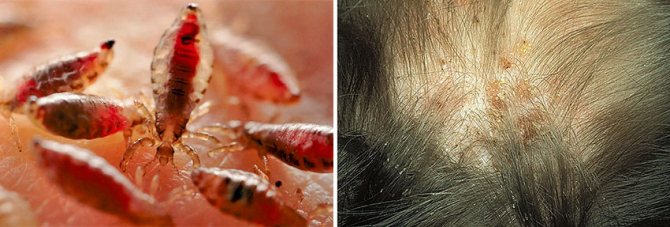

Lavender
Lice Lavender Oil is another prophylactic against head lice. It has antiseptic, analgesic and sedative properties. Many insects are afraid of the lavender scent, and lice are no exception. A rather pungent smell weakens activity, slows down the development and reproduction of lice.
However, it is unlikely that it will be possible to achieve complete destruction of lice with this mixture alone. But its combination with eucalyptus, rosemary or tea tree oil will help not only heal wounds and get rid of dandruff, but also destroy lice. In addition, this herbal combination will help protect against midge bites and even mosquitoes.
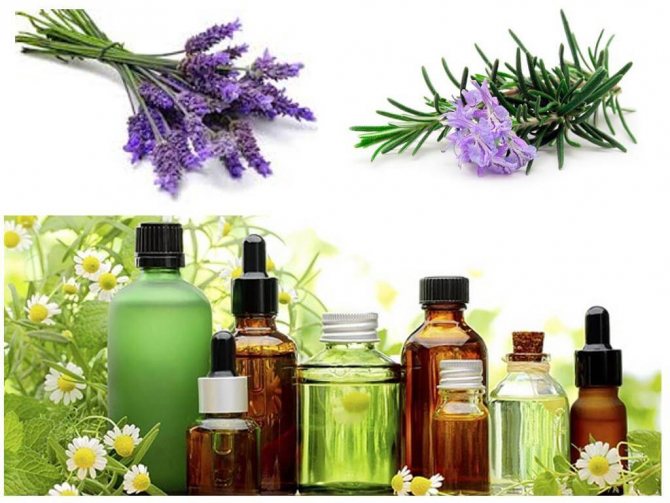

Rosemary and lavender
A pediculicide can also be made with alcohol. It is enough to mix it with lavender ether and distilled water in a ratio of 5: 3: 5. The resulting cocktail is rubbed with a cotton swab into dry hair. The head is wrapped in a plastic bag, and on top with a towel. After 20 minutes, the hair is washed with water and combed with a comb. To get rid of lice completely, this procedure should be repeated at least 4 times.
On a note!
Lavender oil is not recommended for people with sensitive skin and allergic diseases. Its use is undesirable during pregnancy and lactation.
Feedback
Once I tried to remove lice from a child with lavender oil extract. However, it was not possible to get one hundred percent result. As a deterrent, it can and is effective. As for me, it is impossible to cope with such a problem as head lice without pharmaceutical preparations.
Natalia, Simferopol
Combing with a comb
There are special medical combs on sale that are good at removing lice from the hair. The long teeth have a minimal clearance that does not impede the free passage of hair, but does not allow lice to pass through. After the procedure, parasites remain on the steel comb, which can be easily washed off with water.
By itself, combing is unlikely to help get rid of insects: it is impossible to catch every single one, and tenacious nits on the hairs are not at all amenable to mechanical removal. The disadvantage can be solved by complex removal: for example, folk remedies used for lice work perfectly only with the use of a comb. After applying the product, the insects die and are well combed out, and the nits come off the hair and do not pose any more danger.
Sunflower
Vegetable oil is also used in the fight against head lice. It suffocates the lice by filling their spiracles. Sunflower oil will not harm the skin and hair, so its use is completely safe for children or pregnant women. However, the process of removing lice in this way takes more than 10 days.
The agent is applied to the hair and scalp with massaging movements, after which a bag and a towel are used similarly to the previous methods, and left in this state for 30 minutes. Then they act according to the same scheme: they are washed and combed out with a comb.
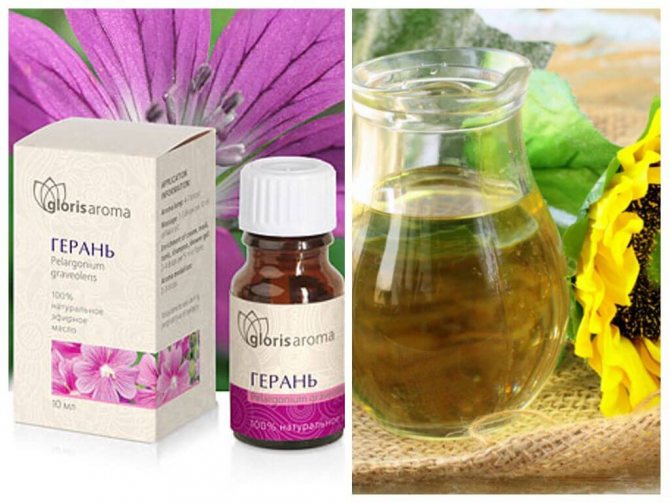

Geranium and sunflower oil
Precautions
During the use of oil compositions, safety rules should be adhered to. Since they are toxic, which can harm an organism weakened by parasites. You must adhere to the following rules:
- It is necessary to use drugs with an unexpired shelf life of well-known manufacturers.
- Care must be taken to ensure that the components do not enter the esophagus. Since they can lead to poisoning, stomach pain, vomiting, hallucinations.
- The recommendations in the recipe should be followed. Since a high concentration can lead to burns.
- Essential substances should only be used in a diluted state.
- It is necessary to ensure that the composition does not get on the mucous membrane of the eyes.
- It is forbidden to carry out treatment on an empty stomach. Inhalation of essential substances can make you feel worse and cause dizziness.
We recommend reading: what are the dangerous lice, what diseases they carry.
Is it possible to withdraw using folk remedies?
To begin with, since grandmother's methods of treatment are still alive, it means that they have proven their effectiveness. You can get rid of the problem of head lice with such recipes, another question is how much time and effort it will take. There are both pros and cons here. Traditional medicine advocates say the following:
- Most of the compositions have a natural base, because berries, oils, decoctions, etc. are used for cooking. Accordingly, there is less chance of rejection or side effects.
- You can use several products at the same time, they do not interfere with each other, which usually increases efficiency.
- Availability of materials: at least 30% of the ingredients are in every home, and those that are in short supply can be quickly purchased at an affordable price.
But if everything looked so beautiful, no one would spend on pharmaceutical medicines, and the very existence of parasites would have long gone into history.
- The effectiveness of homemade formulations is an order of magnitude lower than that of their competitors from the pharmacy. Therefore, the course of treatment can take up to 1 month (the life cycle of lice is 1 month).
- It will not be possible to solve the problem at once, you have to be patient and prepare for repeated and systematic procedures.
Contraindications to use
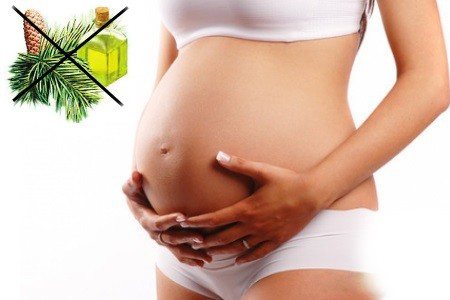

The most common ones are:
- too early childhood (up to 6 years);
- pregnancy;
- lactation;
- bronchial asthma.
It is recommended to consult your doctor before use. Ingestion may cause the following side effects:
- vomiting;
- diarrhea;
- headaches;
- pain in the stomach;
- hallucinations.
The use of any means must be in strict adherence to the instructions, observing all the opposite measures. Before using it is recommended to consult a specialist. It is impossible to treat lice with essential oils only. It is recommended to use it in conjunction with medicated shampoo, spray or other traditional medicine recipes.
Preventive measures
According to statistics, every fifth child has lice. The social stereotype imposes the idea that head lice occurs only in dysfunctional families or below the average income level. This is an erroneous opinion, since despite the good development and reproduction in oily curls, lice love to infect clean hair.
The best treatment for head lice is head lice prevention. Its main rule is to adhere to the rules of personal hygiene, as well as the use of prophylactic agents and careful care of the hair. Lice prevention is possible at home, or rather, it is extremely necessary. We will consider the main measures for the prevention of head lice in separate points.
Hygiene rules
Personal hygiene, in addition to regular bathing, includes other measures:
- check your head and the child's head for lice once a week;
- prevent contact with infected people and those living in unsanitary conditions;
- exclude casual sex;
- regular shampooing depending on the type of hair (oily hair is washed more often, dry - less often);
- if you suspect head lice, ask someone close to you to carefully examine the head, especially at the roots - nits are usually formed there;
- regularly wash clothes, bed linen, periodically take blankets and pillows for cleaning;
- use essential oils, they have a double effect: they repel lice and improve the condition of the scalp and hair;
- periodically use antiparasitic hair products in small quantities to prevent head lice. Relevant when visiting unsanitary places or contact with a sick person.
Shampoos and sprays
Taking a small amount of head lice prophylaxis every two weeks will reduce the risk of head lice.You need to use sparing products with a mild effect, since the strong ones are aimed at destroying a large number of parasites, and the weak ones scare them away with their smell. Separately, it should be noted tar detergents. There is a special tar shampoo for hair, it dries out the skin and hair less than bar soap. But at the same time, its use not only prevents the appearance of head lice, but also has a beneficial effect on the hair.
- Couple Plus - a spray used to prevent head lice on clothes or bedding;
- Veda and Veda-2 - lice shampoos with the active substance permethrin, which paralyzes lice and nits;
- Nyx is a cream, the active substance is permethrin;
- Pedikulen-ultra - produced in the form of an aerosol, it contains essential oils, which are also afraid of parasites;
- Paranit comes in three forms: shampoo, lotion and aerosol, so you can choose a more convenient one to use. Contains Clearola oil, which repels lice and helps to remove nits from hairs. It should be noted that the substance does not kill the parasites themselves, it only helps to more effectively carry out the subsequent combing;
- Bubil is a product with a combined composition, and the main components are pyrethrin and acetic acid, which helps to peel off nits.
Essential oils
Essential oils are known as skin and hair care products. But few people know that such a pleasant oily smell for us can be an excellent protection against lice. These parasites really hate the smells of certain oils:
- Tea tree.
- Eucalyptus.
- Lavender.
- Bergamot.
- Geranium.
First application: apply a few drops to the temples and the area behind the ears, in the hairline, then lubricate the comb with a couple of drops and lightly treat the hair along the entire length with a couple of drops. Natural oils have a rather persistent smell. Even when we get used to it and do not feel it, the parasites feel it at a distance. Therefore, oil prophylaxis against lice is very popular.
Second use: add 3-4 drops of ether to shampoo while washing your hair. Lice protection, hair and scalp strengthening, pleasant smell guaranteed!
Other preventive measures
Also, do not forget that pubic lice are in second place from head lice. To prevent accidental infection, it is recommended to abandon casual sexual intercourse and maximally protect yourself by removing excess body hair (without treatment, head lice spreads to all hairy parts of the body).
If there is suspicion of infection, it is recommended to purchase a special anti-parasite comb. This item is one of the best remedies for the prevention of lice and nits.
Healing mixtures
Essential substances must not be used in their pure form. They come as an add-on to the base product. Faster results can be obtained when using tandems based on several types of oils. When making a mixture, you need to adhere to several recommendations.
- the mixture is made using one main component and 2 additional components in a ratio of 30 to 3. Vegetable oil is taken as a basis. Most often, burdock, castor is used for these purposes. The addition is usually lemon, rosemary, tea tree;
- the resulting mixture is heated in a water bath to room temperature;
- then evenly distributed over the head, hair;
- keep for 2 hours.
Sour mixtures
An acidic environment is used as an auxiliary component, which helps to remove nits, makes it easier to comb them out. Due to its aggressiveness, vinegar is known in the fight against lice. In a complex composition, it leads to an increase in the result. To prepare the product, you should take:
- 9% vinegar in equal amounts with the main component;
- vegetable base;
- 5 drops of fragrance;
- apply to hair, put on a plastic bag on top;
- after an hour, rinse under running water with detergent;
- dry with a hairdryer;
- comb out nits and paralyzed lice.
Treatment of head lice with olive oil and esters
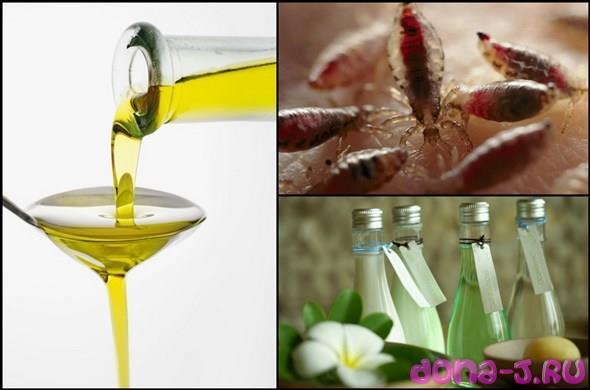

Step-by-step instructions for the treatment of head lice with ethers and olive oil are presented below:
- Pour warm olive oil into a large bowl and add about 3-5 drops of your favorite ester.
- Massage the essential oil mixture into the epidermis and treat each strand with it. Make sure all curls and scalp are covered with the prepared solution.
- The lice will begin to absorb the oil to get nourishment. If there is not enough oil, then you will not be able to deprive the nits of oxygen.
- Ponytail your hair and put on plastic wrap. It should be firmly pressed against the skin. To prevent the oil from staining your clothes, place an unnecessary towel or rag on your shoulders. If oil drips onto your face, wear a bandage over your forehead to absorb the oily solution that spills out.
- You need to walk with such a mask at least 3 and no more than 8 hours. The longer the solution stays on the head, the more likely it is to kill all the nits at once.
- Place a rag or newspaper on the bathroom floor. This is necessary so that after removing the "cap" the oil with the killed lice does not stain the floor. Place a mirror next to the bathroom in which you can see whether you have removed all the lice or not.
- Pour water into the basin and dilute the shampoo in it, dip your head and rinse the curls well. In the basin, you will surely see a lot of dead nits and an oily film.
- Divide the hair into 4 parts, secure each with hairpins and invisible hairpins. Comb each quarter of hair with a fine-toothed comb. This procedure should be carried out in front of a mirror to see if you have combed out all the lice. Comb your hair until all nits are removed.
- Rinse off the oil with dish soap (it will help remove the greasy film from the curls). After that, rinse your hair with regular shampoo.
- Dry the hair with a hairdryer, the heat from this device will help kill and remove living nits and their remnants from the hair.
To completely eliminate the disease, you need to carry out such treatment at least twice a week, after 2-3 weeks you can completely recover from boring head lice.
The course of the disease
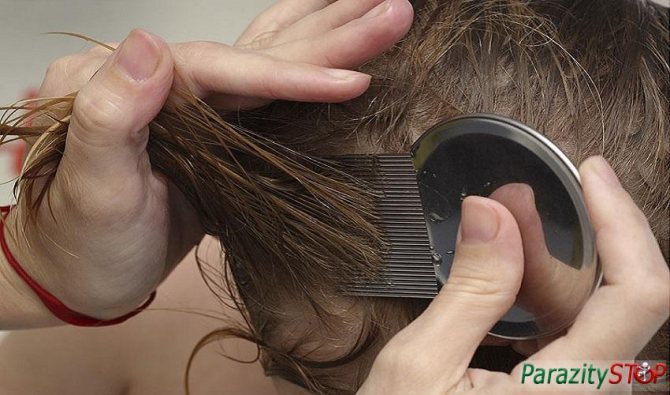

Pediculosis is a parasitic disease that is provoked by lice that take root in the human hair. There are three types of lice - head lice (live exclusively in the scalp), clothes (live and reproduce in bed and underwear, as well as in closets with stale clothes) and pubic (affect the pubic region). They feed on human blood, sucking it through the skin, hence the itching constantly felt by the patient. First, the female lays eggs, they are called nits, they are attached with the help of a mucous secretion to the hair, and there they already undergo the development process to a sexually mature individual.
Reasons for infestation with head lice:
- irregular washing and treatment of the body and head;
- increased sweating, for example, at school, children can run for an hour in physical education, and then put on a hat, which creates extra greasy hair, and this is a direct path to the appearance of lice;
- close communication with a person suffering from head lice.
Signs and symptoms of head lice infestation:
- severe itching that occurs in the affected area.
- Irritation, redness and the appearance of pustular formations in the areas of lice infestation.
- The formation of larvae on the hair.
On the head, the most affected by parasites are the temples and the back of the head. Due to the constant scratching of itchy areas, inflammation, redness occur on the skin, and the nearest lymph nodes may increase in size. In advanced cases, an infection of a bacterial nature begins, which is already fraught with serious consequences for a person.
It is possible to become infected with head lice through towels, bedding, clothes shared with a sick person.
There is an opinion that at the first detection of nits in the head, they must be carefully combed out - and this will prevent the appearance of lice. This statement is fundamentally wrong. It is imperative to treat head lice.
Prevention for infants and preschool children
Babies have a weak immune system and a sensitive body, especially babies. In addition, according to statistics, head lice is more common in kindergarten or school - places where children gather. Therefore, not all remedies are suitable for treatment and prevention. Consider the rules for the prevention of lice for children:
Essential oils. Depending on the age, essential oils are used in different quantities, since the skin of babies is too sensitive even for contact with natural substances. From two weeks of age, lavender oil is suitable for babies. But at such an early age, it is better to play it safe and dilute it with ordinary olive oil - take 2 tablespoons of olive oil for 1 drop of essential oil. Store the mixture in a cool, dark place. From 2 months, the variety of oils is expanding - bergamot, eucalyptus. You also need to dilute with base oil (any vegetable). From half a year, tea tree oil is allowed. For dilution, 2 drops of ether are already used for 2 tablespoons of vegetable oil. From one year on, oils are diluted in the amount of 2-3 drops of ether for a couple of tablespoons of olive or refined sunflower oil. Lavender can be used neat. From the age of 5, the concentration of essential oils (any of the above) reaches 4-5 drops per 2 tablespoons of base oil. From 7 years old - 5-7 drops of essential oil per 2 tablespoons of vegetable oil.
Lavender and hellebore water. They are suitable for prophylactic use for children of any age and do not require additional preparation.
Shampoos. Children use gentle shampoos (Nyx, Veda, Biosim). For prevention, it is used twice a month, after shampooing with ordinary baby shampoo. The procedure is as follows: after washing the hair with a baby product, literally a couple of drops of antiparasitic shampoo are applied, foamed and washed off after a quarter of an hour.
Children's balms. No matter how, at first glance, it may sound, ordinary hair balms can protect a child's hair from parasites. The fact is that using the balm after shampooing makes the hair smoother. Because of this, it is more difficult for parasites to linger on the hair, although their legs are rather tenacious.
Combing comb. A special scallop can be purchased at any pharmacy. The frequency and location of the teeth in the presence of lice and nits makes it easy to comb out the parasites and their eggs from the hair. For the prevention of children, it is recommended to comb the head once a week. If a louse appears, it will be visible on the comb.
Hairstyle. Boys must have a short haircut, and girls are advised to collect their hair as much as possible, especially long hair (bun, braid). Lice easily and quickly sit on loose and long hair, it is more difficult for them to get into a short haircut or tightly gathered hair.
Information. Children 5-6 years old are already smart enough and inquisitive
Often adults prohibit taking or doing anything, and the child's question "Why?" the answer is heard "Because I said so." Children need information, so it is important for them to tell in detail and in an accessible way why they cannot use someone else's comb, wear someone else's hat, or share hairpins and elastic bands with their girlfriends.
Otherwise, the prevention of head lice in children is similar to the conditions for adults - maintaining hygiene, keeping clothes clean, using a separate towel, comb and other personal items that can transmit parasites.
Observing preventive measures, head lice can be detected in time, or even avoided altogether.Indeed, if one family member is infected, the rest by default risk being infected.
Does it help with lice and nits
In terms of antiseptic properties, this substance is significantly ahead of carbolic acid, destroys 8 times more parasites and harmful microorganisms.
It is believed that tea tree sap extract, like other natural preparations, is able to cope with the problem at the initial stage. Launched options require more professional medical intervention. The reasons are quite simple and straightforward:
- First, these insects cannot leave the treatment area. They need to be combed out. The remaining parasites can survive and continue to cause problems for a while. So the processing should be done from time to time.
- Secondly, these parasites have a dense chitinous cover that protects adults from the effects of the substance.
- Thirdly, lice can be poisoned by the substances in the extract for processing if taken with the host's blood. And this is difficult, because it is used for external use.
This aromatic substance can weaken and reduce the activity of adults, interfering with their reproduction. Here, as an additional effect, the obligatory combing out of the parasites with the help of a special comb is required.
